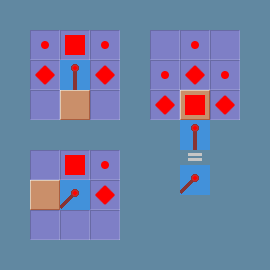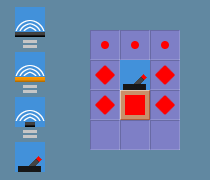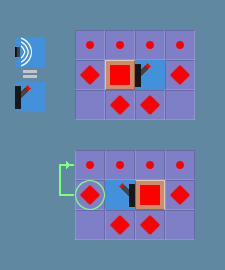Difference between revisions of "Redstone circuitry"
(revamped the page) |
|||
| Line 1: | Line 1: | ||
| − | In general, Mine Blocks | + | In general, Mine Blocks redstone circuits are assumed to behave like 2 dimensional Minecraft circuits, and Minecraft guides are applicable where this wiki is deficient. |
| − | == Major | + | == Major differences between Minecraft and Mine Blocks == |
| − | === Limited | + | === Limited components === |
There are way fewer Redstone components in Mine Blocks compared to those in Minecraft. | There are way fewer Redstone components in Mine Blocks compared to those in Minecraft. | ||
| − | === Phantom | + | === Phantom power === |
The block updating order and internal states are not described here but it can have unexpected and temporary side-effects. | The block updating order and internal states are not described here but it can have unexpected and temporary side-effects. | ||
It is easy to create "phantom" power in ways other than shown above. An off-switch attached to such positions then removed is a reliable remedy unless there is an active source causing it. | It is easy to create "phantom" power in ways other than shown above. An off-switch attached to such positions then removed is a reliable remedy unless there is an active source causing it. | ||
It is also common for tiles that should be powered to remain inactive, or be made inactive by touching unpowered dust for example. The remedy is to force the update to work differently either by resetting power or partial rebuilding. | It is also common for tiles that should be powered to remain inactive, or be made inactive by touching unpowered dust for example. The remedy is to force the update to work differently either by resetting power or partial rebuilding. | ||
| − | === Downward | + | === Downward signals === |
A Redstone torch placed on the side of a block does NOT power the block below it as in Minecraft. | A Redstone torch placed on the side of a block does NOT power the block below it as in Minecraft. | ||
To get downward signals in Mine Blocks without moving parts, you can use the following arrangement.<br> [[File:Rs_down.png]] | To get downward signals in Mine Blocks without moving parts, you can use the following arrangement.<br> [[File:Rs_down.png]] | ||
| − | === No | + | === No redstone ticks === |
In Mine Blocks, there's no such thing as "Redstone ticks", everything happens all at once, which is painful for timing | In Mine Blocks, there's no such thing as "Redstone ticks", everything happens all at once, which is painful for timing | ||
| − | == Redstone | + | == Redstone components == |
''Main Article: [[Redstone components]]'' | ''Main Article: [[Redstone components]]'' | ||
| Line 48: | Line 48: | ||
* [[TNT]] | * [[TNT]] | ||
| − | == Basic | + | == Basic power configurations == |
This is to be used if you have a hard time understanding the complex technical aspects of the next section. | This is to be used if you have a hard time understanding the complex technical aspects of the next section. | ||
| − | === Redstone | + | === Redstone dust === |
When a piece of Redstone dust is powered, it has a full signal, if you carry on that signal by adding another Redstone dust onto the end, it will have a weaker signal, it keeps going like this until 16 blocks out, where the signal will have run out. Unlike Minecraft, Redstone dust does not power blocks 2 blocks below the dust, it has to be directly on top in order to be powered. | When a piece of Redstone dust is powered, it has a full signal, if you carry on that signal by adding another Redstone dust onto the end, it will have a weaker signal, it keeps going like this until 16 blocks out, where the signal will have run out. Unlike Minecraft, Redstone dust does not power blocks 2 blocks below the dust, it has to be directly on top in order to be powered. | ||
| − | === Redstone | + | === Redstone torch === |
Redstone torches will power all sides except for below the torch, and if it's placed on a wall, the block behind it. | Redstone torches will power all sides except for below the torch, and if it's placed on a wall, the block behind it. | ||
| − | === Top-mounted | + | === Top-mounted inputs === |
Top-mounted inputs won't power blocks 2 blocks below like in Minecraft, but it can still power the sides | Top-mounted inputs won't power blocks 2 blocks below like in Minecraft, but it can still power the sides | ||
| − | === Side-mounted | + | === Side-mounted inputs === |
Side-mounted inputs can power below the input, and it can power both sides as well, but not above | Side-mounted inputs can power below the input, and it can power both sides as well, but not above | ||
| − | == Complex | + | == Complex power configurations == |
This is used for a more technical understanding of the game's redstone mechanics. | This is used for a more technical understanding of the game's redstone mechanics. | ||
| Line 70: | Line 70: | ||
[[File:Rs_legend_p.png]] | [[File:Rs_legend_p.png]] | ||
| − | === Redstone | + | === Redstone dust === |
[[File:Rs_dust_p.png|225px|thumb|left]] | [[File:Rs_dust_p.png|225px|thumb|left]] | ||
The green blocks act as relays when present, causing the target tile states to be updated according to the dust state, otherwise, they stay at their last state. The left version overrides the right. | The green blocks act as relays when present, causing the target tile states to be updated according to the dust state, otherwise, they stay at their last state. The left version overrides the right. | ||
<br clear=all/> | <br clear=all/> | ||
| − | === Redstone | + | === Redstone torch === |
[[File:Rs_torch_p.png]] | [[File:Rs_torch_p.png]] | ||
| − | === Top-mounted | + | === Top-mounted inputs === |
[[File:Rs_switchtop_p.png]] | [[File:Rs_switchtop_p.png]] | ||
| − | === Side-mounted | + | === Side-mounted inputs === |
[[File:Rs_switchside_p.png|225px|thumb|left]] | [[File:Rs_switchside_p.png|225px|thumb|left]] | ||
The circled tile remains charged after power is removed, and activates the tile above it, unless explicitly depowered by other means. | The circled tile remains charged after power is removed, and activates the tile above it, unless explicitly depowered by other means. | ||
| Line 91: | Line 91: | ||
<br clear=all> | <br clear=all> | ||
| − | == | + | ==See also== |
| − | [[Redstone | + | *[[Redstone]] |
Revision as of 21:00, 17 February 2020
In general, Mine Blocks redstone circuits are assumed to behave like 2 dimensional Minecraft circuits, and Minecraft guides are applicable where this wiki is deficient.
Contents
Major differences between Minecraft and Mine Blocks
Limited components
There are way fewer Redstone components in Mine Blocks compared to those in Minecraft.
Phantom power
The block updating order and internal states are not described here but it can have unexpected and temporary side-effects. It is easy to create "phantom" power in ways other than shown above. An off-switch attached to such positions then removed is a reliable remedy unless there is an active source causing it. It is also common for tiles that should be powered to remain inactive, or be made inactive by touching unpowered dust for example. The remedy is to force the update to work differently either by resetting power or partial rebuilding.
Downward signals
A Redstone torch placed on the side of a block does NOT power the block below it as in Minecraft.
To get downward signals in Mine Blocks without moving parts, you can use the following arrangement.
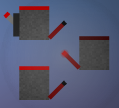
No redstone ticks
In Mine Blocks, there's no such thing as "Redstone ticks", everything happens all at once, which is painful for timing
Redstone components
Main Article: Redstone components
A list of all the Redstone components and their intended functions
Inputs
These components are used as a way for the player to interact with the Redstone contraption.
Transmissions
These components are mainly used to turn the inputs into outputs.
Outputs
These components are usually the end result of a Redstone contraption.
Basic power configurations
This is to be used if you have a hard time understanding the complex technical aspects of the next section.
Redstone dust
When a piece of Redstone dust is powered, it has a full signal, if you carry on that signal by adding another Redstone dust onto the end, it will have a weaker signal, it keeps going like this until 16 blocks out, where the signal will have run out. Unlike Minecraft, Redstone dust does not power blocks 2 blocks below the dust, it has to be directly on top in order to be powered.
Redstone torch
Redstone torches will power all sides except for below the torch, and if it's placed on a wall, the block behind it.
Top-mounted inputs
Top-mounted inputs won't power blocks 2 blocks below like in Minecraft, but it can still power the sides
Side-mounted inputs
Side-mounted inputs can power below the input, and it can power both sides as well, but not above
Complex power configurations
This is used for a more technical understanding of the game's redstone mechanics.
Legend
Symbols for significant power levels with distinct effects.
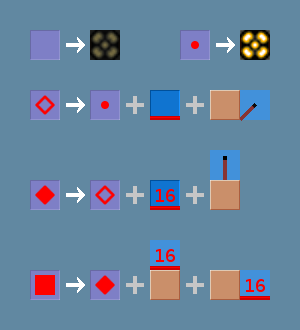
Redstone dust
The green blocks act as relays when present, causing the target tile states to be updated according to the dust state, otherwise, they stay at their last state. The left version overrides the right.
Redstone torch
Top-mounted inputs
Side-mounted inputs
The circled tile remains charged after power is removed, and activates the tile above it, unless explicitly depowered by other means.
Anomalies
The above scheme is simplified for practical use, but there are configurations that it can't describe.

